Welcome to the world where technology and creativity collide, producing the melodious and electrifying tunes that power our playlists! Whether you’re a seasoned musician, a budding podcaster, or a passionate audiophile, having the right audio interface in your setup can be a game-changer. But here’s the catch: high-quality sound doesn’t always have to come with a hefty price tag.
In this article, we dive deep into the realm of affordable yet stellar audio interfaces that promise to elevate your audio production without burning a hole in your pocket.
Navigating through the myriad of options in the audio equipment market can be a daunting task, especially when you’re bound by a budget. But fear not! We’ve sifted through the noise to bring you not just options but informed, practical, and budget-friendly choices under $500. Our research is backed by technical expertise, real-life user experiences, and a genuine desire to help you find the best fit for your unique audio needs.
So, let’s embark on this sonic journey together and explore the best audio interface under 500 bucks that promises to deliver superior sound without breaking the bank.
Related: Best Podcast Mixers
Contents
Best Audio Interface Under 500 Dollars
The market is saturated with options, each promising a unique blend of features, quality, and reliability. But when the budget is capped at $500, making the right choice becomes crucial to ensure every penny is well spent.
In this section, we’ll delve into a meticulously curated list of best audio interfaces that not only fit your budget but also bring a wealth of features, uncompromised sound quality, and a reputation for reliability to your home studio setup.
Focusrite Scarlett 4i4 3rd Gen USB Interface
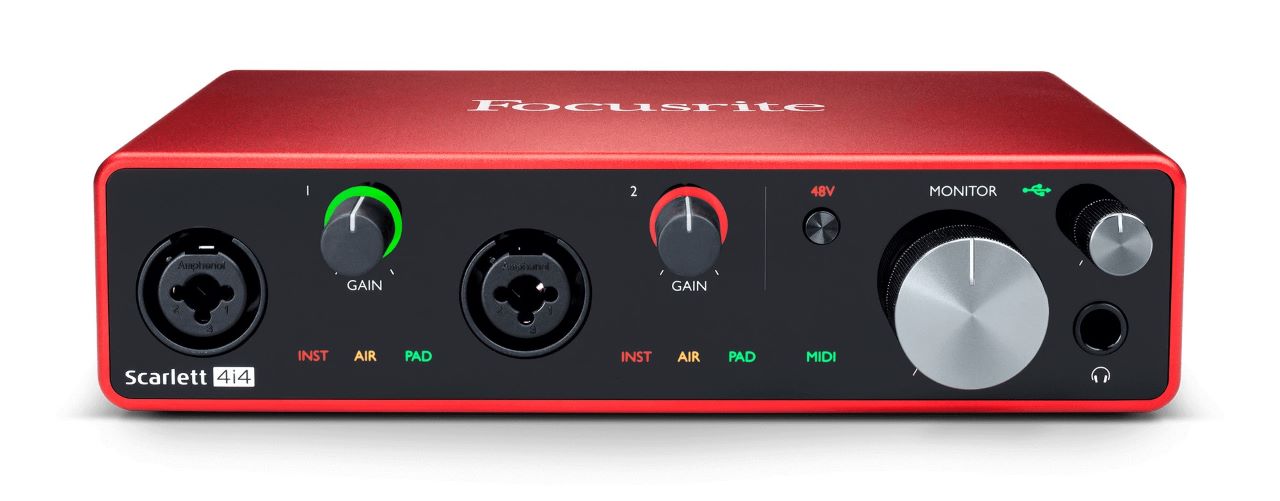
The 4i4’s 24-bit/192 kHz converters deliver studio-quality sound. Image Source.
Key Features
- Two high-quality Scarlett mic preamps
- Four inputs and four outputs
- High-performance 24-bit/192kHz AD-DA converters
- Air mode to enhance vocal recordings
- Robust and compact design suitable for portable use
The Focusrite Scarlett 4i4 3rd Generation interface is a versatile and compact audio interface that provides a robust platform for recording and mixing sound with precision and clarity. It is renowned for its high-quality preamps and the ability to deliver crystal-clear audio, making it a favorite among podcasters, musicians, and audio engineers alike.
The 3rd generation of this interface brings forth enhanced audio drivers and improved preamp design, ensuring that your recordings are of professional quality, whether you’re capturing musical instruments, vocals, or podcasts.
With the Scarlett 4i4, users gain access to two of Focusrite’s best-performing mic preamps, along with two additional line inputs, making it suitable for small to medium-sized recording setups. The interface is also equipped with high-headroom instrument inputs, enabling users to record guitar and bass without any unwanted clipping or distortion.
Furthermore, the Air mode breathes life into vocals, adding a unique high-end detail, while the high-performance converters enable you to record and mix at up to 24-bit/192kHz.
Pros
- High-quality audio recording and playback
- Versatile with multiple input and output options
- Compact and portable design
- User-friendly interface suitable for beginners and professionals
Cons
- May require additional adapters for certain microphone setups
- Software bundle may not cater to all user needs
Steinberg UR-RT2 Interface
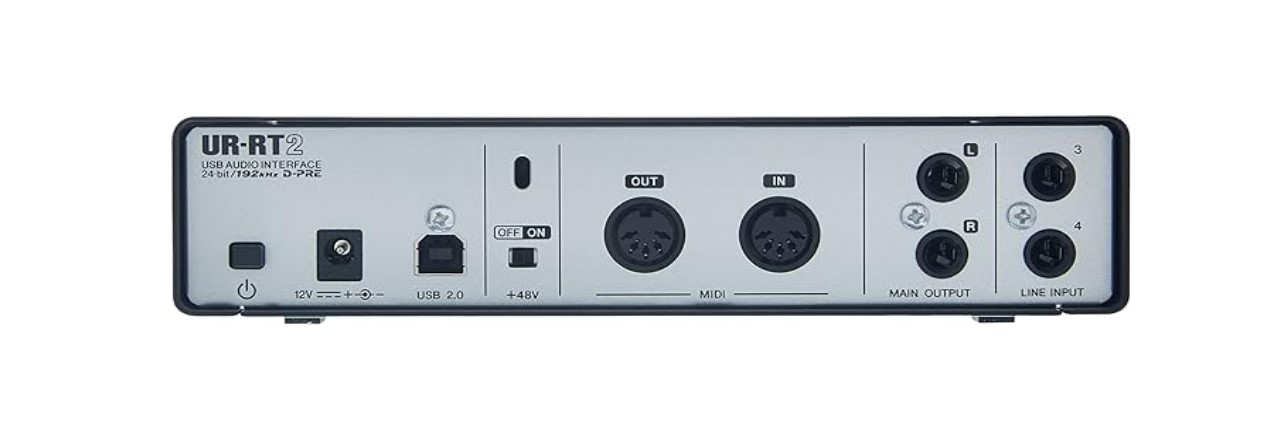
The Steinberg UR-RT2 has 24-bit/192 kHz USB 2.0 audio interface with 4 x 2 analog I/O and MIDI I/O. Image Source.
Key Features
- Provides latency-free monitoring with effects
- It can be used with Windows, macOS, and iOS
- Supports 24-bit/192 kHz audio recording and playback
The Steinberg UR-RT2 Interface is a premium-quality audio interface that integrates the renowned technology of Rupert Neve Designs into its compact and robust design. It offers a USB 2.0 audio interface with 24-bit/192 kHz, ensuring high-definition sound quality.
The interface is equipped with 2 Class-A D-PRE mic preamplifiers which are complemented by convertible Rupert Neve Designs transformers, providing a rich musicality and harmonic detail to your recordings.
Keeping in +48 V phantom power and a Hi-Z switch on the microphone preamps, it provides versatile connectivity for various audio sources, such as microphones and guitars. The UR-RT2 also offers DSP-powered monitoring by the REV-X reverb, Channel-Strip, and Guitar Amp Classics (also available as VST 3 plugins). It ensures low-latency monitoring, which is crucial for recording sessions.
The interface is compatible with Windows, macOS, and iOS, providing flexibility across various platforms and recording environments. Moreover, it includes Cubase AI and Cubasis LE music software to kickstart your recording and production journey.
Pros
- The integration of Rupert Neve Designs transformers ensures a premium sound quality
- Can be used across various platforms and supports different audio sources
- Comes with Cubase AI and Cubasis LE, providing a good start for music production
Cons
- Some users have reported difficulties and complexities during the software installation process
- Some users have noted that it might not be the best fit for stereo recording due to its monitoring capabilities
Audient iD4 USB 2-in/2-out High-Performance Audio Interface
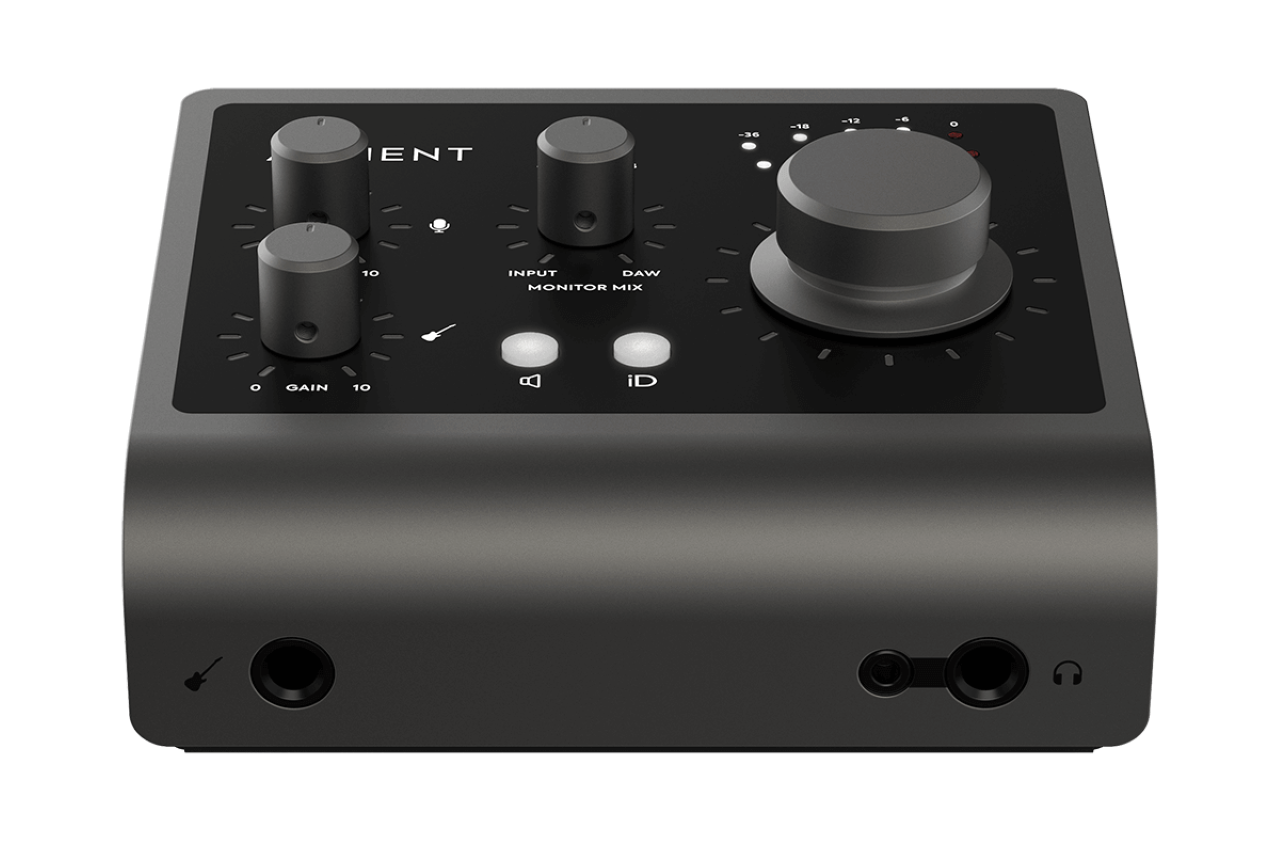
iD4’s converters make sure you hear every nuance, every detail of your audio, letting you hear your mix more accurately. Image Source.
Key Features
- Class-A Mic Preamplifier for transparent and accurate sound
- JFET D.I. input for connecting guitars and other instruments
- Zero-latency monitoring for real-time audio recording and processing
- Dedicated headphone output for accurate audio monitoring
- USB connectivity for compatibility with various devices and platforms
The Audient iD4 is a compact and robust audio interface that provides a powerful platform for both recording and monitoring applications. It is a USB interface that boasts high-performance capabilities in a user-friendly design, making it an ideal choice for musicians, podcasters, and content creators who demand professional-grade audio quality. The iD4 is renowned for its pristine audio quality, ensuring that recordings are clear, detailed, and free from unwanted noise.
This interface is equipped with a Class-A mic preamplifier, which is recognized for delivering accurate and transparent sound. It also features a JFET D.I. input for connecting guitars, basses, and other instruments, ensuring a harmonically rich and dynamic recording.
The iD4 also provides zero-latency monitoring, which is crucial for recording applications, and it features a dedicated headphone output, ensuring accurate audio playback. Additionally, it offers a versatile range of connectivity options, including USB, making it compatible with various devices and operating systems.
Pros
- Compact and robust design, suitable for both studio and mobile use
- High-quality audio recording and playback with minimal noise
- Versatile connectivity options, ensuring compatibility with various setups
- User-friendly interface, making it accessible for both beginners and professionals
Cons
- The unit might require additional configuration or settings adjustment for optimal performance in some setups
Presonus Studio 192 USB 3.0 Audio Interface

The PreSonus Studio 192 USB 3.0 audio interface delivers exceptional sonic fidelity, flexible connectivity, and professional monitoring and mixing controls. Image Source.
Key Features
- 24-bit, 192 kHz USB 3.0 interface and studio command center
- Up to 26 inputs x 32 outputs (8×14 at 192 kHz)
- 2 mic/instrument inputs and 6 balanced mic/line level inputs with remote-controllable mic preamps
- Talkback routing, with fat channels processing, preamp control, and speaker switching
- Pristine analog signal path with first-class 118 dB digital conversion
- Tight integration with Studio One for multitrack music production; Studio One Artist and Studio Magic Plug-in Suite included
The Presonus Studio 192 is a versatile audio interface combined into one rack space. It offers a 24-bit, 192 kHz USB 3.0 audio interface that provides outstanding sonic fidelity, yielding connectivity, and maestro monitoring and mixing controls.
Studio 192 is designed to be the central hub for any project or professional studio, featuring simultaneous I/O up to 26 inputs x 32 outputs (8×14 at 192 kHz). It also includes 2 mic/instrument inputs and 6 balanced mic/line level inputs with XMAX remote controllable mic preamps.
The Studio 192 is not just a computer audio interface but also a studio command center that provides zero-latency surveillance with preamp control, Fat Channels processing, and speaker switching from incorporated Studio One Artist or UC Surface.
It ensures an immaculate analog signal path with prime-quality 118 dB digital conversion. The device is tightly integrated with Studio One for multitrack music production, and it comes with Studio One Artist and Studio Magic Plug-in Suite, making it compatible with most music software for Mac or Windows.
Pros
- Offers a wide range of inputs and outputs for various recording setups
- Ensures professional-grade sound quality with its high-end digital conversion and preamps
- Works seamlessly with Studio One and includes a suite of plug-ins and software
- Allows for real-time monitoring without delay, enhancing the studio quality recording experience
Cons
- Some users might find the extensive features and controls to be overwhelming, especially for beginners
Behringer U-PHORIA UMC404HD Audio Interface

The UMC404HD has 4×4 USB 2.0 Audio/MIDI Interface for recording microphones and instruments. Image Source.
Key Features
- Audiophile 24-bit/192 kHz resolution for professional audio quality
- 4 state-of-the-art, MIDAS-designed Mic Preamplifiers
- Zero-latency direct controlling during recording
- +48 V phantom power
The Behringer U-PHORIA UMC404HD is a powerhouse audio interface that offers a perfect balance of functionality and affordability for musicians and podcasters. With its 4×4 USB 2.0 Audio/MIDI Interface for recording microphones and instruments, it provides a comprehensive platform for various audio recording and processing applications. The UMC404HD is recognized for its audiophile 24-bit/192 kHz resolution, ensuring that the recordings are of high fidelity and professional-grade quality.
The interface is equipped with 4 state-of-the-art, MIDAS-designed Mic Preamplifiers, which are celebrated for their high-quality sound output in the audio industry. Furthermore, it comes with Zero-latency lead monitoring during recording and features +48 V phantom power for studio condenser mics. The UMC404HD also provides powerful phone output along with Level control and Monitor A/B source selected for DJ-style cueing.
Pros
- High-resolution audio recording and playback
- Multiple input and output options for versatile connectivity
- Robust build quality and reliable performance
- Affordable pricing, offering great value for money
Cons
- Might be slightly complex for beginners due to numerous features and settings
- Some users might prefer a more compact design for portability
M-Audio M-Track 8X4M Audio Interface
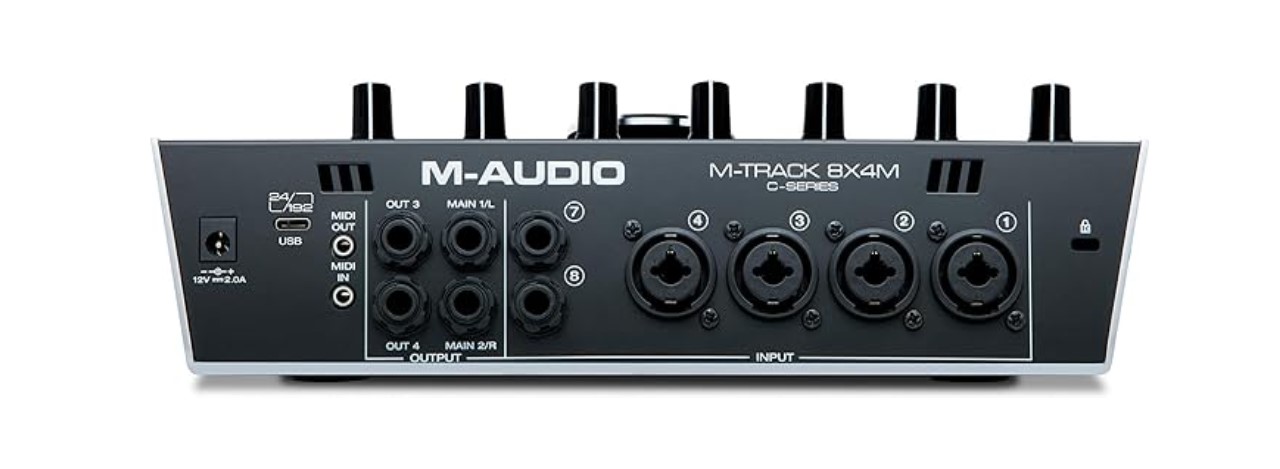
The M-Track 8X4M has 24-bit/192kHz resolution for professional recording and monitoring with hi-Speed USB connection for zero-latency monitoring. Image Source.
Key Features
- 24-bit/192 kHz resolution for professional recording and monitoring
- Multiple inputs, including combo XLR+¼TRS, instrument, and line inputs
- USB/Direct balance knob for zero-latency monitoring
- Durable metal chassis and large central control for volume adjustment
- Comes with Pro Tools First | M-Audio Edition, Eleven Lite, Ableton Live Lite, and more
The M-Audio M-Track 8X4M is a compact USB/USB-C audio interface that provides a platform for professional-grade audio recording and monitoring with its 24-bit/192 kHz resolution. It features a robust metal chassis and a large central control for easy volume adjustment.
The interface is equipped with 4 XLR+¼TRS combo inputs, 2 ¼-inch instrument inputs, and 2 ¼-inch line inputs, along with 2 ¼-inch headphone outputs with independent source and level controls. Moreover, it offers zero-latency direct monitoring and is capable of connecting virtually any external MIDI equipment through its input/output.
Pros
- Allows for recording from various sources simultaneously
- Crystal preamps ensure a clear, low-noise signal
- A suite of professional software enhances recording and production capabilities
- Ensures longevity and reliable performance
Cons
- Some users have reported difficulties and glitches with the drivers and software
- May require additional amplification for certain microphones
Mackie Big Knob Studio
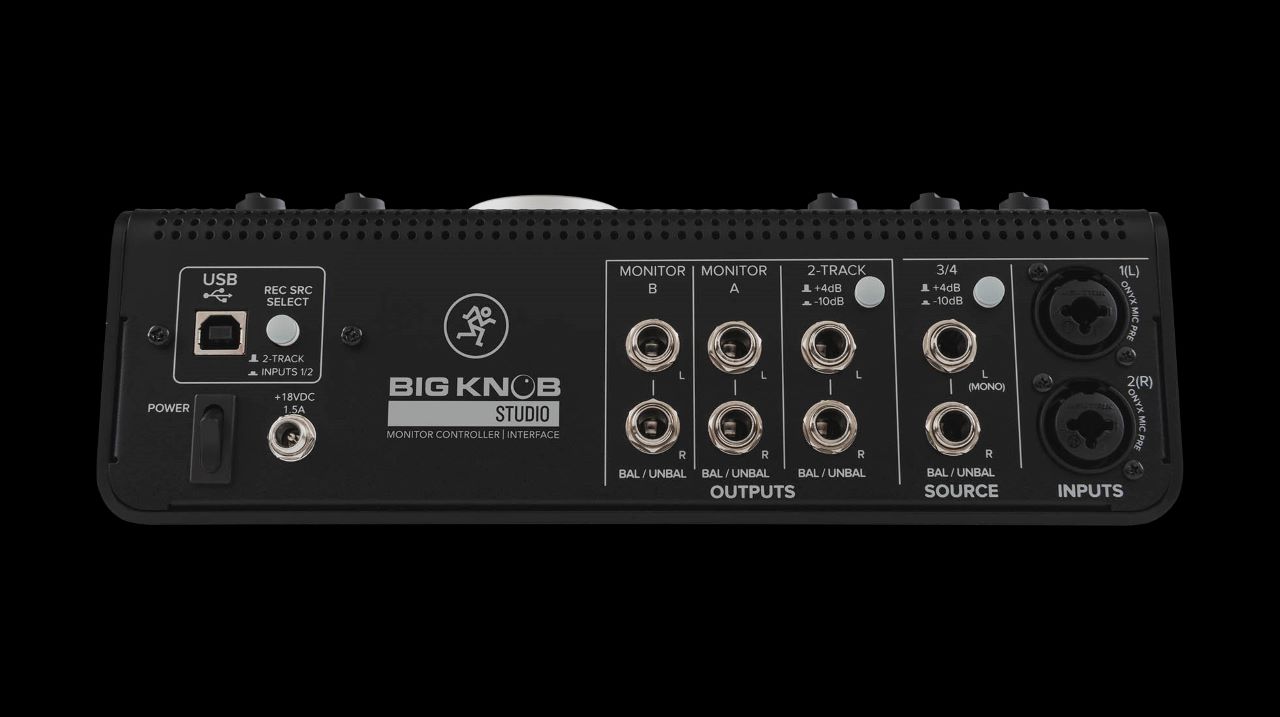
The Mackie Big Knob Studio has two boutique-quality Onyx mic preamps including phantom power for condenser microphones. Image Source.
Key Features
- Comprehensive I/O to connect with various audio equipment
- Available in Studio and Studio+ models, enabling direct digital recording and playback
- Manage your audio levels accurately with the robust, tactile knob
- Communicate easily with artists through the built-in talkback microphone (available in Studio and Studio+ models)
The Mackie Big Knob is a renowned lineup of studio control surfaces and interfaces designed to cater to the needs of musicians, producers, and audio engineers. The series is celebrated for providing professional source/monitor selection and precise level control in a robust and compact design.
The Big Knob Series is available in three different models: The Passive model, the Studio model, and the Studio+ model. This model is tailored to meet specific needs and applications in the studio environment. The Passive model offers a simple 2×2 monitor controller, while such models provide additional features like USB recording/playback and comprehensive I/O for flexible integration with various audio gear.
Pros
- Intuitive design and controls make it easy to navigate and operate
- Robust build quality ensures durability and longevity
- Suitable for various applications, from simple monitoring to complex studio setups
- Consistent and stable performance in various studio scenarios
Cons
- Some users might find the unit to be somewhat bulky for smaller studio spaces
Key Features To Consider When Choosing An Audio Interface Under $500
Navigating through the myriad of audio interfaces available in the market can be a daunting task, especially when you’re constrained by a budget. However, a limited budget of $500 still offers a plethora of viable options, each boasting a unique set of features tailored to different audio recording and processing needs.
Let’s delve into some key aspects that you should consider to ensure that your chosen audio interface under $500 aligns perfectly with your requirements.
Input And Output Channels
The input and output channels of an audio interface are pivotal in determining how many audio sources and destinations can be connected simultaneously. For solo musicians or podcasters, an interface with a couple of inputs might suffice. However, for band recordings or more complex audio setups, you’ll require more inputs and outputs to accommodate all the instruments, microphones, and other audio sources.
When considering I/O channels, it’s crucial to evaluate your current needs and also anticipate any future expansion of your setup. For instance, if you plan to record a drum kit in the future, you’ll need multiple inputs to accommodate various microphones for different drum elements. Similarly, multiple outputs can be beneficial for sending audio to different monitors, amplifiers, or external hardware processors.
Connectivity Options
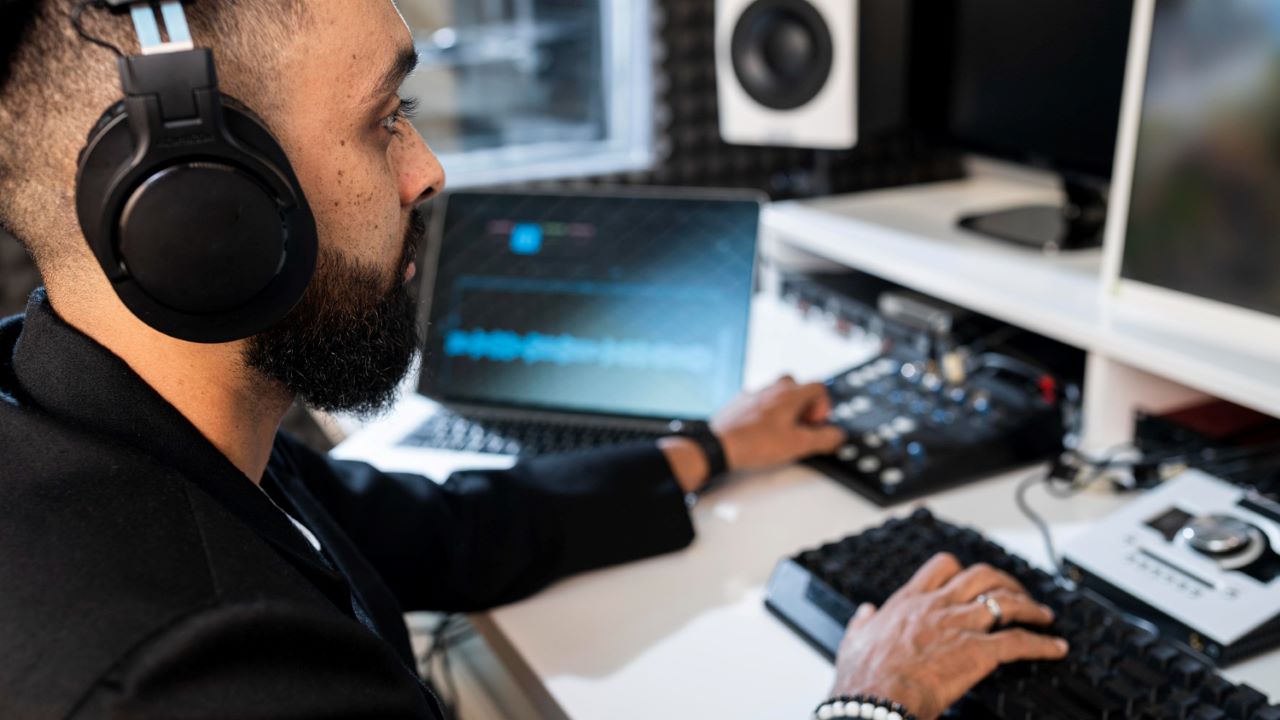
Image by Freepik
In the realm of audio interfaces, connectivity isn’t just about how many devices you can connect, but also about how the interface connects to your computer. USB is the most common and universal type of connection, but other options like Thunderbolt and USB-C offer faster data transfer rates, which can be crucial for minimizing latency during recording and playback.
Moreover, considering the types of inputs (XLR, TRS, etc.) and outputs (line outputs, headphone out, etc.) is also vital. Ensure that the interface has the necessary connections for your microphones, instruments, and monitoring systems. Also, ponder upon MIDI connectivity if you plan to integrate MIDI controllers or other MIDI gear into your setup.
Bit Depth And Sample Rate
Bit depth and sample rate are critical factors that influence the audio quality of your recordings. Higher bit depths and sample rates offer enhanced audio quality but also demand more storage space and processing power. Most professional recordings are done at a bit depth of 24 bits and a sample rate of 48 kHz, which is considered a standard in many professional settings.
However, some interfaces offer higher sample rates (up to 192 kHz), which might be beneficial for certain applications like sound design or when recording high-frequency instruments like cymbals. It’s essential to strike a balance between obtaining high-quality recordings and managing your system’s storage and processing capabilities.
Build Quality And Portability
The build quality of an audio interface is paramount, especially if you plan to use it in a mobile recording setup. A robust and durable interface will withstand the rigors of travel and frequent handling. Metal chassis and reinforced knobs and jacks can enhance the longevity of the interface.
Portability is another vital aspect, especially for musicians and creators on the go. Compact and lightweight interfaces that do not compromise on essential features are invaluable for mobile recording setups, ensuring that you can create high-quality audio wherever inspiration strikes.
Software Inclusions
Many audio interfaces come bundled with software to get you started with recording, mixing, and mastering your tracks. This might include Digital Audio Workstations (DAWs), plugins, virtual instruments, and other creative tools that can be pivotal in crafting your audio.
Ensure to check the software inclusions and their compatibility with your operating system. Some interfaces come with lite versions of popular DAWs, which can be a great starting point for beginners. Also, consider the availability and quality of drivers, ensuring that the interface can communicate effectively with your computer and software.
Each of these aspects plays a crucial role in determining the suitability of an audio interface for your specific needs. By carefully evaluating each feature and considering how it aligns with your requirements and workflow, you can ensure that your chosen audio interface under $500 offers the best value and performance for your investment.
FAQs
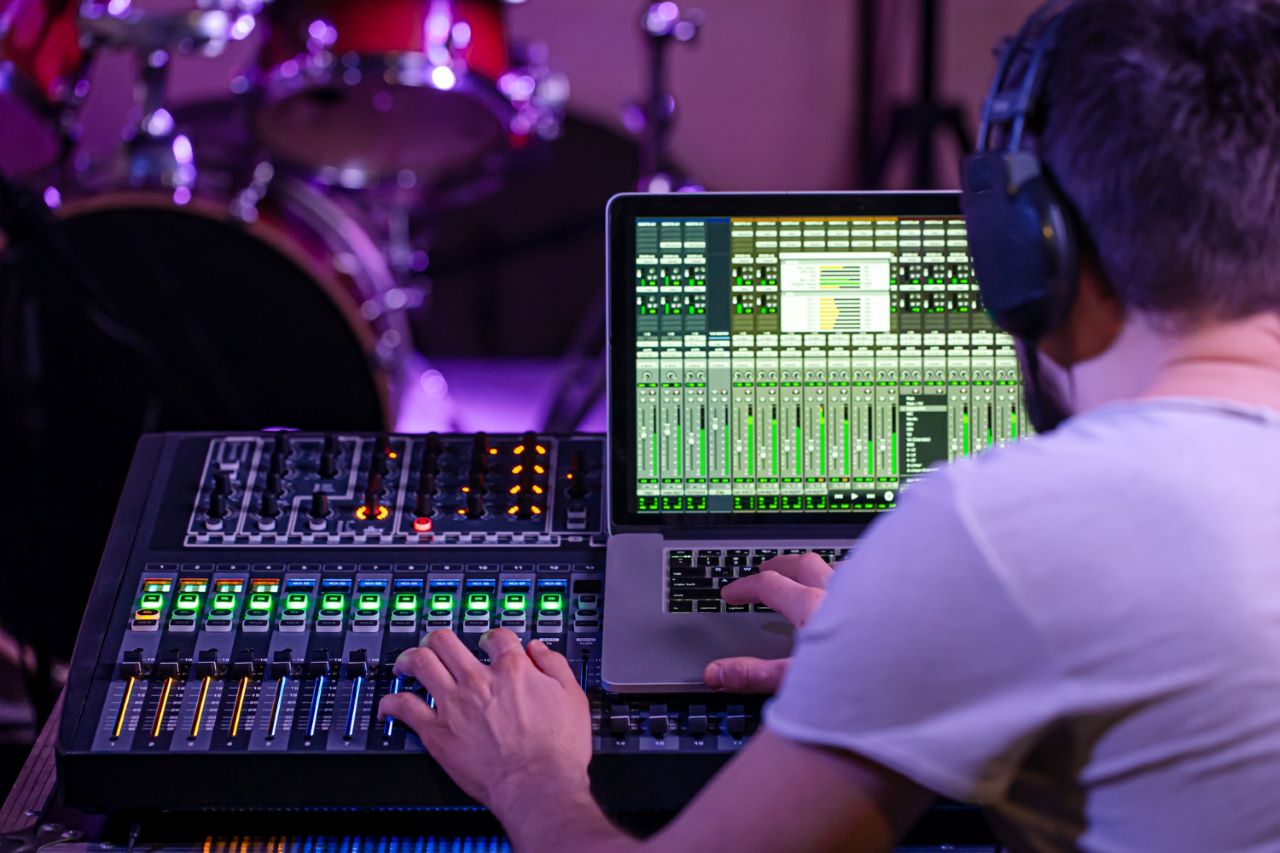
Image by pvproductions on Freepik
How Much Should I Pay for an Audio Interface?
Determining how much to invest in an audio interface hinges on various factors, including your budget, recording needs, and the level of professionalism you seek in your recordings. For beginners or hobbyists, an interface in the range of $100 – $200 might suffice, offering decent audio quality and enough mic inputs and outputs for simple recording setups.
Mid-range interfaces, which fall between $200 and $500, often provide a balance between quality and affordability, offering better preamps, higher sample rates, and more connectivity options. Professional interfaces, which can range from $500 and upwards, offer premium components, enhanced durability, and additional features that can significantly uplift the quality and versatility of your recordings.
Related: Best Audio Interface Under 100 Dollars and Best Budget Mic Preamp
What Type of Audio Interface is Best?
The “best” audio interface is subjective and is largely determined by your specific needs and use cases. For solo artists or podcasters, a simple, compact interface with one or two inputs might be ideal. For bands or multi-instrumentalists, an interface with multiple inputs and outputs would be more suitable.
Consider factors like the type of instruments and microphones you’ll be recording, the recording environment, and your technical expertise. USB interfaces are generally recommended for beginners due to their ease of use and compatibility, while more advanced users might opt for Thunderbolt interfaces due to their low latency and high data transfer rates.
Do Expensive Audio Interfaces Make a Difference?
Expensive audio interfaces often provide enhancements in various aspects, such as improved audio quality, lower noise levels, more connectivity options, and better build quality. High-end interfaces might feature premium analog-to-digital converters and microphone preamps, ensuring that the recorded audio is transparent and accurate.
They might also offer advanced features like digital signal processing (DSP), higher sample rates, and more comprehensive software bundles. These features can make a noticeable difference in professional and commercial recording environments where the utmost audio quality and reliability are paramount.
Are Expensive Audio Interfaces Worth It?
The worthiness of investing in an expensive audio interface is contingent upon your recording needs, budget, and future aspirations in audio production. For professional studios and serious musicians, a high-end interface could be a worthwhile investment due to the enhanced audio quality, reliability, and additional features they offer.
However, for beginners, hobbyists, or those with a limited budget, a mid-range or entry-level interface might provide sufficient quality and functionality for their needs. It’s crucial to assess whether the additional cost translates to meaningful improvements and benefits for your specific use case.
Final Thoughts
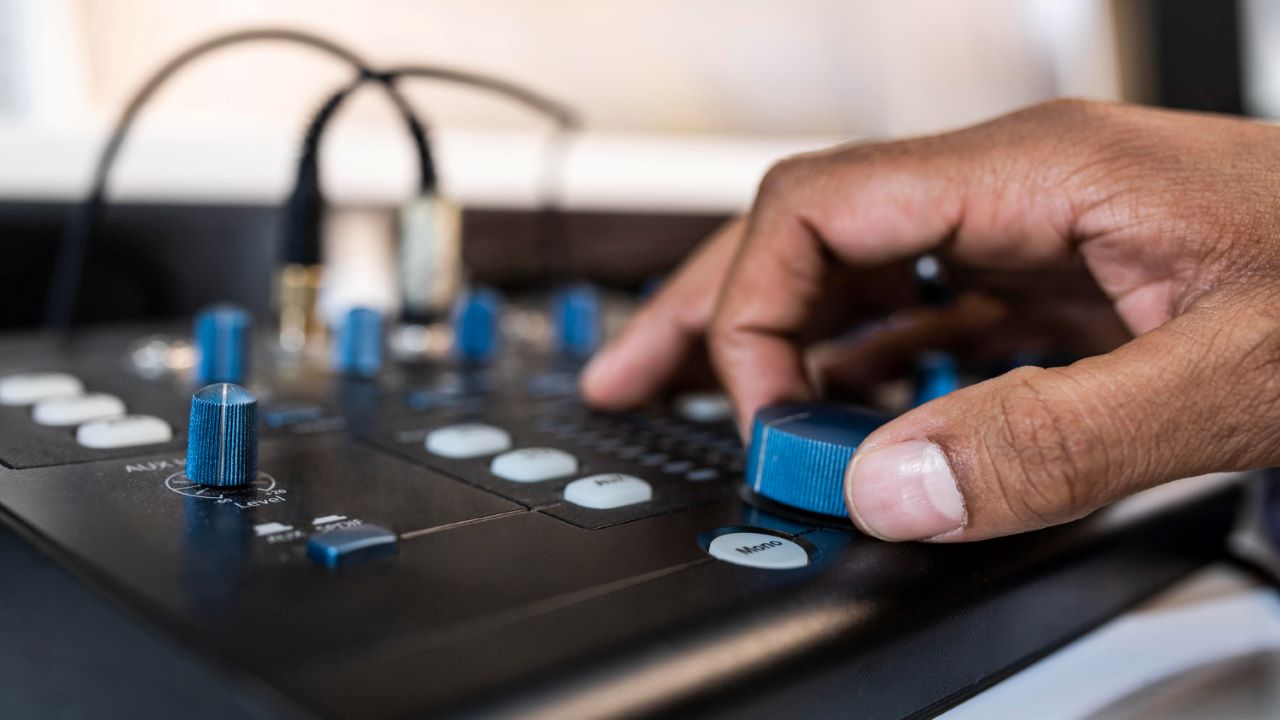
Image by Freepik
Venturing on the journey of selecting the superior audio interface, especially under a budget of $500, intertwines a blend of technical, financial, and personal considerations. Throughout this comprehensive guide, we’ve navigated through the pivotal aspects of audio interfaces, delving into the nuances of input/output channels, connectivity options, bit depth, sample rate, build quality, portability, and software inclusions.
Each facet is crucial, sculpting the audio recording and processing experience and ensuring that the resultant audio resonates with clarity, depth, and precision.
Reflecting upon the products we’ve explored, such as the Focusrite Scarlett 4i4, Presonus Studio 192, and the Behringer U-PHORIA UMC404HD, each interface brings forth a unique set of features and capabilities, catering to varied recording needs and environments.
The Mackie Big Knob Series, for instance, offers a versatile range of models, each tailored to specific studio requirements, while the Steinberg UR-RT2 Interface integrates the revered technology of Rupert Neve Designs, ensuring recordings that are not only high-quality but also rich in harmonic detail.
The Audient iD4, with its Class-A mic preamplifier and JFET D.I input, offers a compact yet powerful recording solution, especially for musicians and creators on the move.
The essence of choosing an audio interface transcends mere technical specifications. It’s a decision that should be harmoniously aligned with your recording aspirations, current and future setup, and of course, budgetary constraints.
Whether you’re a budding podcaster, an aspiring musician, or a seasoned audio engineer, the interface you choose becomes an integral part of your creative process, influencing not only the quality of the audio but also the fluidity and enjoyability of the recording experience.